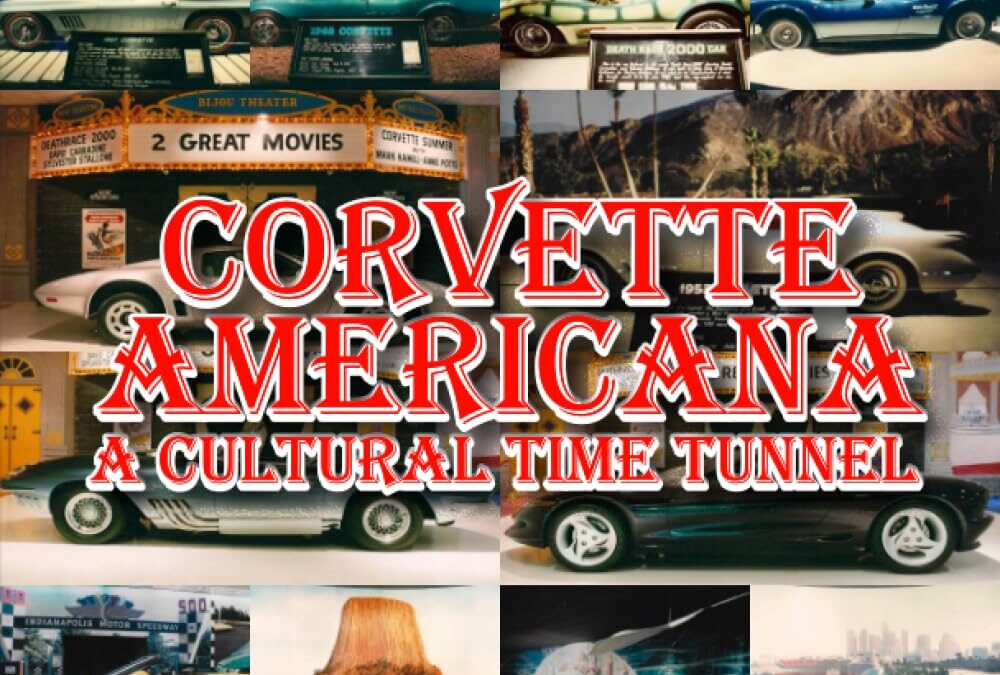
Allen Schery is perhaps the first Anthropologist to have designed a Car Museum. Prior to his design we generally only see rows of cars with small signs. Allen’s unique idea was to place each car in a set featuring a giant 15 x 30-foot photo mural that utilized a curved dioramic wall to give a 3-D effect incorporating a symbol of American Culture as a backdrop. Allen then took several trips around America logging in some 20,000 miles of trips procuring pictures of Mt. Rushmore, Niagara Falls, The Golden Gate Bridge, the Alamo, and other well-known American Landmarks. Each set featured real earth scenes and stage lighting. The Corvette was used as a time-coordinated symbol of American Culture to anchor the exhibit. He then theorized that as the original owner of each car placed the key in the ignition he was surrounded by the culture of a bygone year of Americana. He sought to recreate the sights. sounds and memories of that bygone culture by using the music, television, and movie snippets of that year along with slides of news events and time-coordinated artifacts. The Museum won many awards as well as being chosen as one of the ten best museums in New York State. Each room became a time capsule to that year with the entire museum a giant time tunnel.
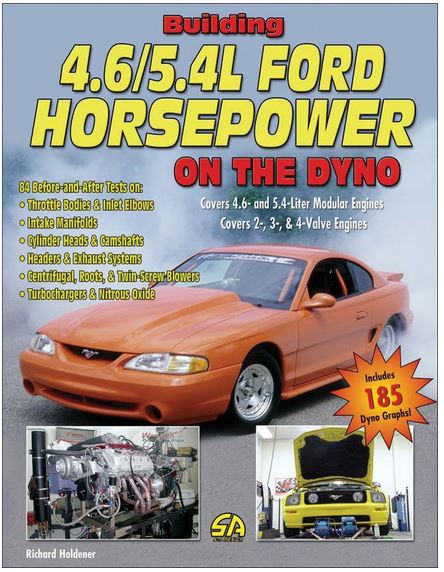
The 4.6- and 5.4-liter modular Ford engines are finally catching up with the legendary 5.0L in terms of aftermarket support and performance parts availability. Having a lot of parts to choose from is great for the enthusiast, but it can also make it harder to figure out what parts and modifications will work best. Building 4.6/5.4L Ford Horsepower on the Dyno takes the guesswork out of modification and parts selection by showing you the types of horsepower and torque gains expected by each modification.
Author Richard Holdener uses over 340 photos and 185 back-to-back dyno graphs to show you which parts increase horsepower and torque, and which parts don’t deliver on their promises. Unlike sources that only give you peak numbers and gains, Building 4.6/5.4L Ford Horsepower on the Dyno includes complete before-and-after dyno graphs, so you can see where in the RPM range these parts make (or lose) the most horsepower and torque. Holdener covers upgrades for 2-, 3-, and 4-valve modular engines, with chapters on throttle bodies and inlet elbows, intake manifolds, cylinder heads, camshafts, nitrous oxide, supercharging, turbocharging, headers, exhaust systems, and complete engine buildups.
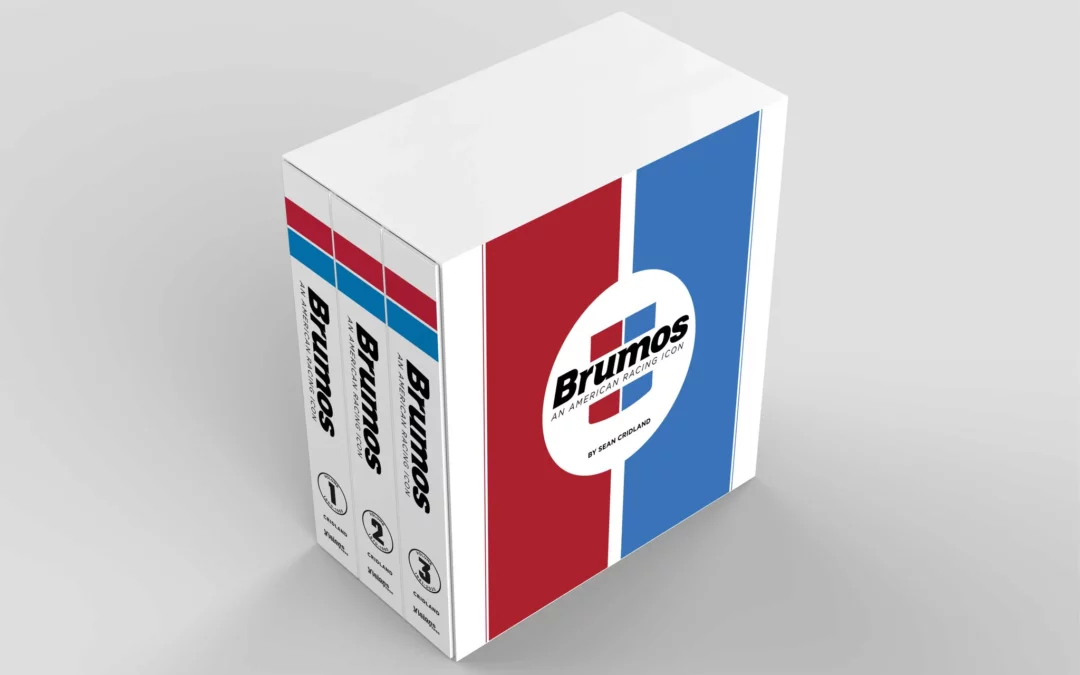
Brumos: An American Racing Icon, by Sean Cridland covers the entire history of the Brumos team, going back to its roots in the early days of the 20th century, all the way up to the opening of the Brumos Collection in January 2020…and everything in between! The three volume set contains 1,500 pages with over 2,000 images, many never before seen.
Volume 1 Chronicles the historical events that led to the creation and development of one of the world’s most legendary teams.
Volume 2 Describes the explosive 1970s when Peter Gregg, Hurley Haywood, Jack Atkinson, and Porsche owned American GT racing.
Volume 3 Examines the challenges and victories of Brumos in the post-Peter Gregg era, from early 1981 until 2020.
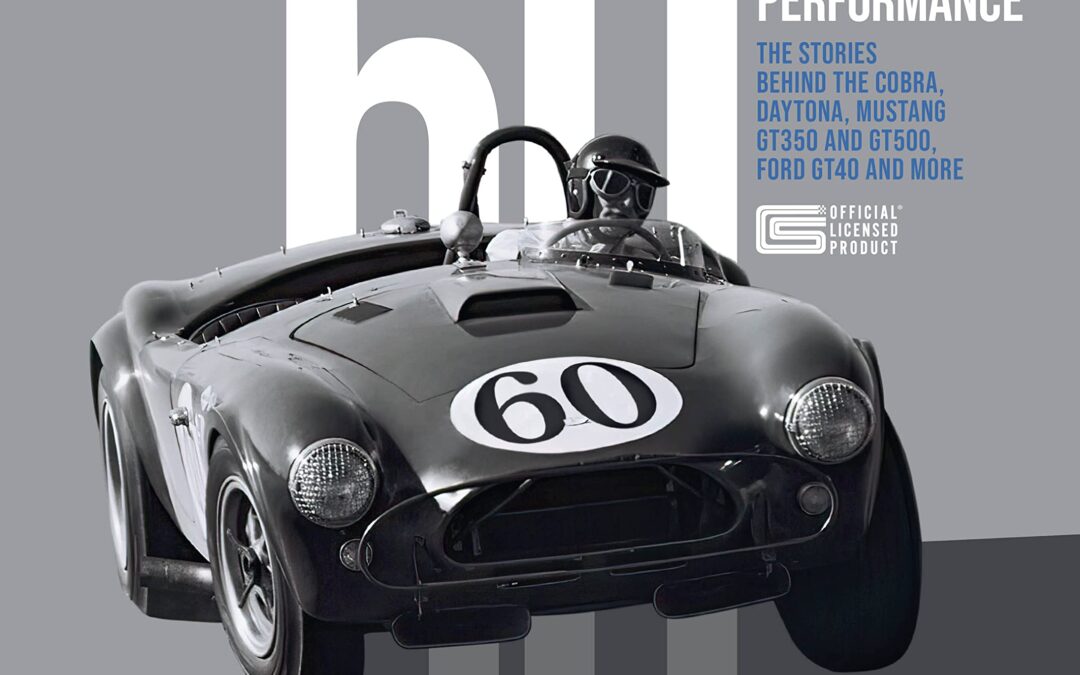
Six Decades of Shelby performance—from the first Shelby AC Cobra to today’s Mustang Shelby GT500!
A bad heart forced Carroll Shelby, one of the top racing drivers of all time, to retire in 1960. But that didn’t stop the lanky Texan from continuing to make history. He launched Shelby American in 1962 with the creation of the brilliant Ford-powered AC Cobra, soon to dominate both U.S. and international sports car racing. Shelby’s winning ways soon led to Ford seeking Shelby’s team of “hot rodders” help to make the Ford GT program a success. It worked. Shelby and Ford soon stunned the motorsports world by winning Le Mans and dominating other venues from 1966 to 1969 with the GT40. Fifty-three years later the legendary first Le Mans win of 1966 would form the basis for the acclaimed film Ford Versus Ferrari. As if the Cobra, Daytona Coupe, and GT40 were not enough, this small team of hot rodders, fabricators, and race mechanics also created the Shelby Mustang GT350 in 1965, and the GT500 two years later. Shelby American was nothing short of lightning in a bottle from 1962-1970.
Shelby American 60 Years of High Performance covers all of these early triumphs, following the proceedings from a small shop in Venice, California, to sprawling digs at LAX all the while developing new road cars, running a top race team, and giving privateer racers the cars they needed to win. Get to know Shelby, as well as the innovators who surrounded him, including designer Peter Brock, genius engineer Phil Remington, “Mr. GT350” Chuck Cantwell, and a roster of top drivers that included Ken Miles, Bob Bondurant, Dan Gurney, Bruce McLaren, Denny Hulme, A.J. Foyt, Mario Andretti, and more.
Authors Colin Comer and Rick Kopec, leading Shelby historians, follow the Shelby story through Carroll’s post-Ford relationship with Dodge, including his roles in the giant-killing, pocket-rocket Shelby Charger, GLH (“Goes Like Hell”), and GLH-S cars along with a slew of other Shelby-ized machines including his role in the birth and development of the menacing Dodge Viper.
The story of the late Carroll Shelby and the company he founded is a classic tale of ingenuity, grit, and perseverance. Illustrated throughout with rare period imagery and modern color photography, Shelby American 60 Years of High Performance is the ultimate tribute to Shelby American and the team that made it all happen.

Pre-order now for early 2023 delivery
Can-Am! The words are still magic to a generation of road racing fans to whom the Canadian-American Challenge Cup series represents the pinnacle of the sport they love. And who is to argue? Taking over from the USRRC (United States Road Racing Championship), as the feature sports car circuit in North America, from 1966 through 1974 the world’s best drivers and the world’s best racing teams put together cars that followed the rule of the Can-Am series: no rules! Anything went, as long as it had two seats and enclosed wheels. These “rules” set the stage for years of ground-and-pulse-pounding cars powered by bigger and bigger engines and daredevil drivers competing in front of motorsport’s biggest crowds. Years later the names still carry weight: drivers like Dennis Hulme, Bruce McLaren, Dan Gurney, Jackie Stewart, Mark Donohue, George Follmer. And what cars: McLaren, Lola, Porsche, Ferrari, and Shadow. But who was behind those awesome machines and drivers? Who could keep them going when the torque shook loose engine bolts? Who could spend an entire low-paid off season in small, cold and drafty race shops looking for an extra edge in performance and reliability? Who could toil in uncomplaining anonymity behind the scenes while the cars and their drivers basked in the considerable glory that went with Can-Am racing? The men portrayed in One Last Turn.
One Last Turn presents the first look at the men (and in those days they were all men, young men) who made it all work. The mechanics who towed the mighty cars on pick-up trucks and worked on them between races and between heats in the blazing sun and pouring rain on muddy grassy fields, who drove 90 miles per hour on the era’s two lane roads, towing a 2000 pound race car to make the next race’s starting grid.
Illustrated with many never before seen photos of the cars and people who made Can-Am great, this is the book that fans of the series have been waiting for.
The men who kept the machines on the track during the Can-Am years
Hilarious and poignant never-before told stories behind the scenes during the Can-Am years.
- Hard cover with dust jacket
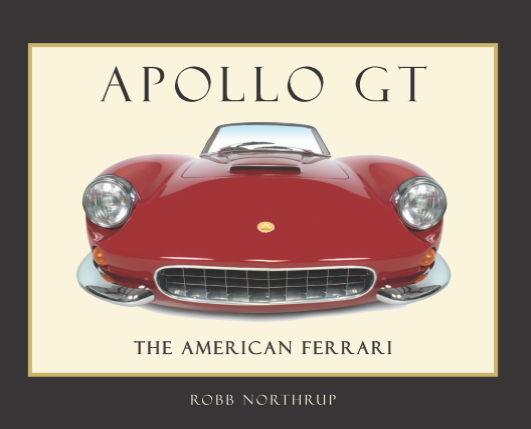
‘If a Buick Special ever got a fierce ambition to become a Ferrari – and tried hard enough – it would be likely to end up just about like this.”
Car and Driver magazine – September, 1963
Such prophetic words from Car and Driver magazine back in 1963 underscore the goal of three California twenty somethings who sought to build a world-class grand touring sports car. And, for a while, found themselves on equal ground with Europe’s best.
Their concept: A marriage of Italian style and the mechanical excellence of a premier American manufacturer – Buick – to create a true gran turismo sports car with head-turning looks, outstanding performance and comfort, and something that, up to then, was not common among European exotics: Reliability!
Their challenges were legion: A complex product combining hand-crafted bodies with mass-produced engines and transmissions on an assembly line spanning two continents and an ocean. A limited capability for product development and testing. And the need to create a marketing program to promote the car to an enthusiast public as well as develop a distribution channel to get the car into their hands. All this with limited operating capital.
The result? The Apollo was highly praised by both road testers and owners alike. “Workmanship is of the highest quality…comparable to cars costing twice that of the Apollo” crowed one magazine report. “…the Apollo handles as well or better than a 2+2 Ferrari, an Aston Martin DB4 or a Sting Ray Corvette,” exclaimed another. High praise indeed from the critical press!
And the owners? “I dearly love my Apollo!” enthused singer Pat Boone. And this from another owner: “It’s a wonderful work of art. You can see the quality. You can feel the excitement they felt when they were hammering it out, putting it together and driving it for the first time. It is a milestone, a one-of-a-kind car and no one can really compare anything to it. It stands on its own.”
This is the story of the Apollo GT. The American Ferrari.
Details: 8.5″ x 11″, 138 pages. 87 color and black & white photos and illustrations.

RS ICONS COLLECTOR’S EDITION
EVERYONE LOVES A SECRET – THIS BOOK IS FULL OF THEM.
In the 1970s and ’80s Ford Design was a hotbed of talent. As its gifted designers thought ever-more out of the box they pushed forward the boundaries of mainstream car design.
This amazing two-book Collector’s Edition is the fascinating – yet never previously told – story of how the world’s best design team created not just some of the era’s most fondly remembered cars but hundreds of others that have never been seen before.
It pulls the covers off an astounding, scarcely believable array of one-offs, prototypes, and cancelled cars that were kept secret. They are revealed in previously private photographs and extraordinarily rare design sketches.
Ford gave the author – a former Ford product designer – first-time access to its most confidential archives and more than 50 former Ford designers and engineers opened up their long-concealed files.
Everyone loves a secret: these previously hidden cars have waited decades to tell you theirs.
-Over 100 never-seen cars revealed
-Design stories of the most iconic ’70s and ’80s Fords
-Forewords by Ford’s former chief designer and engineer
-Insiders’ stories of the ultimate unicorn: Escort RS1700T
-Beautiful design sketches – published for the first time
-Head-spinning prototypes and one-offs
Two-book Collector’s Edition includes the following:
- Signed and numbered by the author
- Additional Scrapbook containing over 200 additional images and never-told stories
- Beautiful, boxed slipcase for both books with unique artwork
- Two free “Secret Fords” posters worth £9.50 each
- Limited to 600 sets
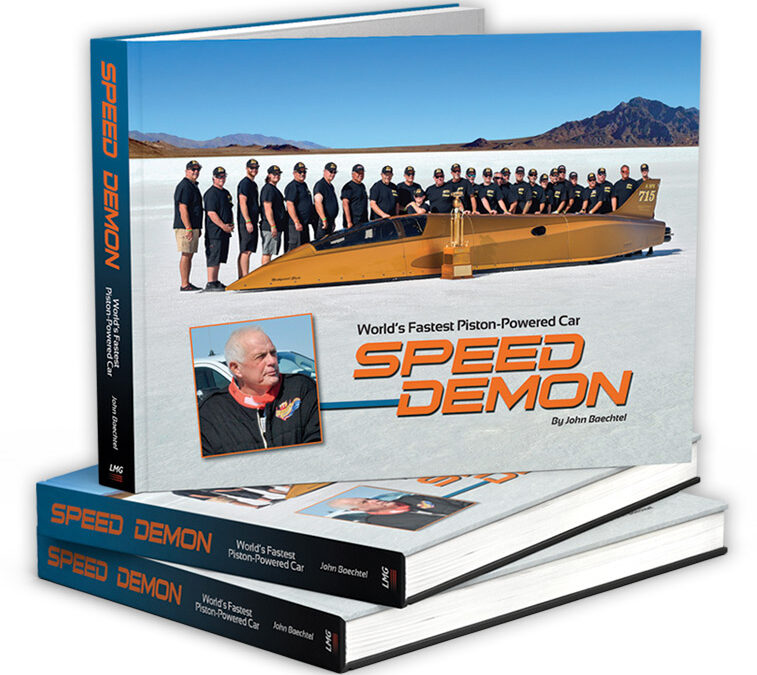
CHASING 5OO
Learn What it takes to plan,build and campaign a land speed record cart capable of achieving 500 mph
Veteran landspeed racer John Baechtel has released a new full color, photo rich history and technical account on the original record setting Speed Demon and the more formidable Speed Demon II which has already set new records at Bonneville
It includes full coverage of the Speed Demon’s extraordinary history and performance record, the unfortunate crash and subsequent construction of the all new Speed Demon II. The new car build is covered in exacting photographic detail so readers can see and understand every component of this amazing landspeed racing car.
George Poteet’s awesome Speed Demon has captured the attention of the world wide racing community with it’s clockwork ability to tear off repeated 400 mph blasts at the Bonneville Salt Flats. When an unfortunate incident caused the car to crash in 2014, an opportunity to build an even better and faster Speed Demon presented itself. See the complete history of the Speed Demon and the detailed buildup of the new car all in full color here.
Take a full color deep dive into the inner workings of the Speed Demon.
George Poteet’s Speed Demon defies nearly all traditional norms for land speed record breaking. It’s logged 55 runs over 400 mph and has captured nine Hot Rod Magazine Top Speed trophies.
It only has one engine, but it’s currently a turbocharged big block Chevy beast. Learn its secrets and why it began as a small block engine. It’s rear-wheel drive in an all-wheel-drive environment. It’s driven by a self-made, nerves-of-steel southern gentleman who places all his faith in crew chief Steve Watt, his engine builder, Kenny Duttweiler, and the extraordinarily talented build crew at Maxwell Industries — the Men in Black.
After a walk-away crash in 2014, an all-new leaner, meaner Speed Demon was constructed at Maxwell. Records continued to fall, culminating in a new 470 mph record and a staggering 481 mph exit speed in 2020. This is story of perhaps the most successful land speed car ever and why it’s so damned fast.
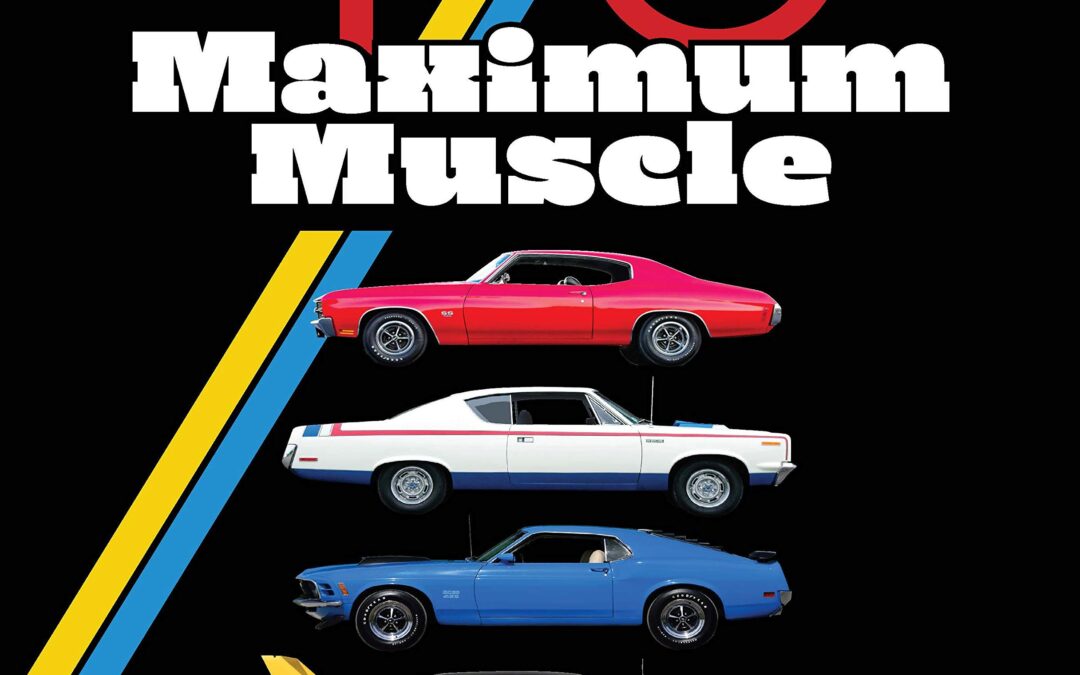
In 1970, the American muscle car was as fast and outrageous as it would ever get. But the end was nigh, and 1970 Maximum Muscle dives head-first into the storm before the calm.
Wherever you mark the beginning of the muscle car era—Oldsmobile’s 1949 Rocket 88, Chrysler’s 1951 FirePower engines, the 1964 Pontiac GTO—one thing is certain: in 1970, the era that had witnessed a parade of gloriously powerful, stylish, and brawny cars apt to make the hearts of even the most dispassionate squares go pitter-patter was sucking fumes. Gasoline shortages, skyrocketing fuel prices, insurance-industry bean counters, rising ecological concerns, and new, more fuel-efficient imports all conspired to consign the American muscle car to an ugly and unseemly denouement. Yet 1970 saw the actual zenith of the cars themselves, the year manufacturers pulled out all the stops and produced the most powerful and stunning machines the automotive world had ever seen.
1970 Maximum Muscle not only explores the factors that led to the decline of the most exciting era in the American automotive industry, it details some of the new models and model options that arguably made 1970 the climax of the muscle car era from engineering, styling, and cultural standpoints. As the war among GM, Ford, Chrysler, and AMC played out at dealerships, dragstrips, and drive-ins, ready-and-willing gearheads drove off dealer lots in potent behemoths like the Buick GSX, Oldsmobile 4-4-2, and Ford Torino Cobra. Muscle car stalwarts like the SS Chevelle, Pontiac GTO, and Plymouth ’Cuda became available with optional LS-6, Stage 1, and Hemi engines, respectively. Manufacturers ratcheted up the advertising hyperbole at the same time, offering performance packages with names like “Six-Pack,” “Ram Air,” and “Cobra Jet,” while spoilers, scoops, hood tachometers, and decal packages were de rigueur. Meanwhile, on the popular SCCA Trans Am circuit, top drivers campaigned more nimble muscle off-the-rack cars like the Camaro Z/28 and Boss 302 Mustang.
1970 Maximum Muscle is an entertaining and rollicking look at the muscle car’s peak year!
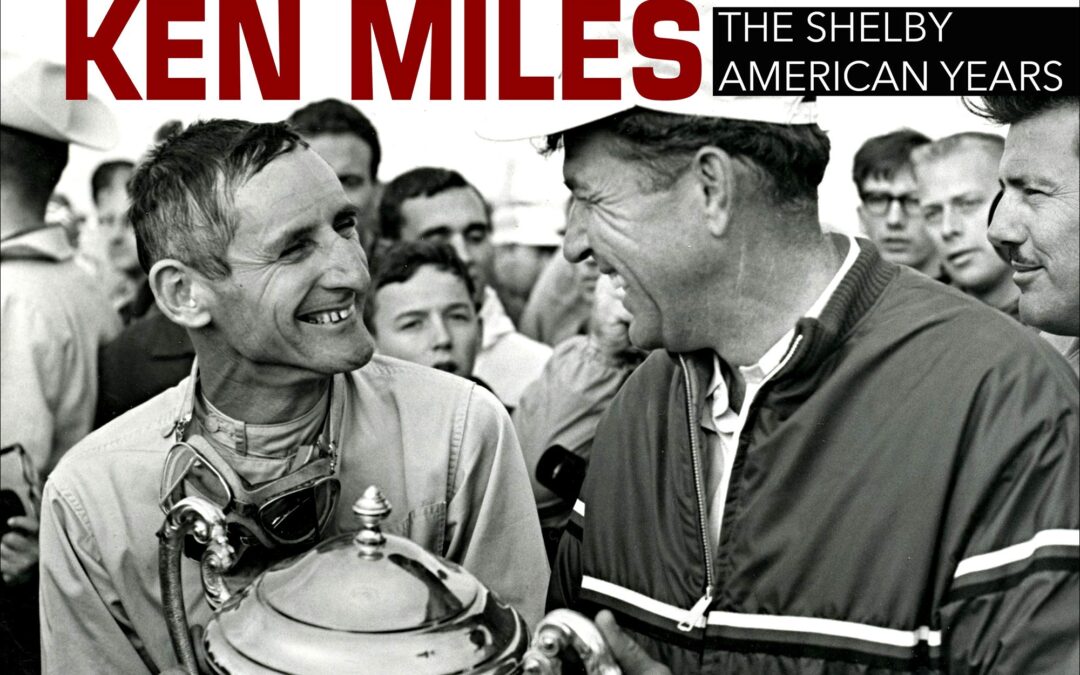
Ken Miles is one of the most famous sports car racers in history, and his time at Shelby American was the pinnacle of his career.
Ride shotgun with Ken Miles through the twists and turns of Sebring, Laguna Seca, Riverside, and Le Mans as seen through the lens of Shelby American photographer Dave Friedman!
The hiring of Ken Miles by Carroll Shelby in February 1963 initiated arguably the greatest pairing of driver/owner partnerships in the history of motorsports. Not only did Shelby hire Competition Manager Ken Miles as an accomplished road racer but also Miles brought professionalism, innovation, and a keen attribute of being able to surround himself with budding, talented individuals.
The list of race cars that Ken piloted at Shelby American is nearly unrivaled: the Shelby 289 Cobra, 390 Cobra, 427 Cobra, King Cobra, Shelby Daytona, Mustang GT350R, and Ford GT. Ken dominated the 1964 United States Road Racing Championship (USRRC) racing season by winning 8 of 10 races to secure the Manufacturers’ Championship. However, it was at Le Mans where Ken Miles became a worldwide household name.
The robbery that was the 1966 24 Hours of Le Mans is laid out in excruciatingly accurate detail as Ford royalty Carroll Shelby, Carroll Smith, Homer Perry, Leo Beebe, Charlie Agapiou, Bob Negstad, Carroll Smith, and Peter Miles recall the race and the tragedy that followed two months later.
Recapture Ken Miles’s career as told by esteemed Shelby American photographer Dave Friedman in this firsthand account titled Ken Miles: The Shelby American Years!

Enigmatic American Don Nichols, D-Day paratrooper, Army counter-intelligence officer and controversial entrepreneur, went on to create a racing marque that seems as cloaked as the man himself. Shadow was the only US-based team to win a Can-Am championship, and one of only three to score a victory in Formula 1. Yet history lavishly celebrates his nominal rivals Dan Gurney and Roger Penske, while Nichols has long remained, yes, a shadowy figure — despite staying the difficult international course far longer, for 11 racing seasons, 1970 to 1980. But at last Pete Lyons, who was there in the day, lifts the veil from this secretive man and the innovative, extraordinary, magnificent racing cars and world-class team he created.
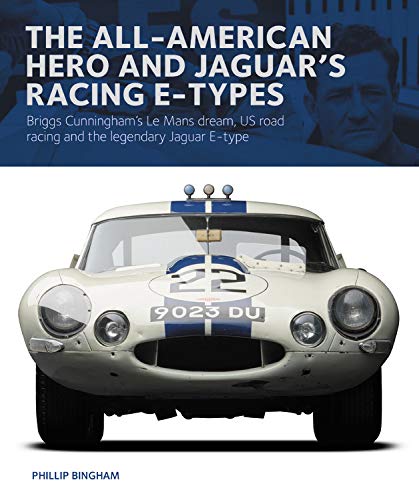
First seen by the wider world at the 1961 Geneva Motor Show, the Jaguar E-type redefined perceptions of how a sports car could – and perhaps should – look. No less a figure than Enzo Ferrari is said to have described it as “the most beautiful car in the world”. Small wonder that demand swiftly exceeded supply after Jaguar initially laid down plans to build the car in relatively small numbers.
It was an instant hit on racing circuits too: little more than a month after the launch, Graham Hill took a roadster to victory on its debut at Oulton Park. Chassis 875027, the focus of this story, was the first E-type campaigned by American racing entrepreneur Briggs Cunningham’s famous team and its performances helped persuade Jaguar to use the E-type as the basis for a competition thoroughbred that has become one of the most coveted of all time: the Lightweight
- The E-type evolved from a distinguished series of Jaguar sports cars that notched up a sequence of victories at Le Mans in the 1950s. The car’s development is covered in detail and illustrated with exquisite cutaways.
- Briggs Cunningham had an interesting tale to tell away from motorsport – as did many of his racing companions. He skippered the winning yacht in the America’s Cup; his right-hand man Alfred Momo won the Targa Florio as a co-driver, aged 14, and later climbed onto the wing of an airborne biplane to repair a leaking fuel line. Their contrasting backgrounds are covered in detail.
- Before aligning with Jaguar, Cunningham harboured hopes of putting together an all-American team capable of winning the Le Mans 24 Hours. His eponymous cars made their mark, without ever quite fulfilling his dream, and feature as part of an engaging wider story.
- In addition to running some of motorsport’s best-known names, including Bruce McLaren, Dan Gurney and Jack Brabham, Cunningham was also associated with several unsung heroes. Here, racers such as John Fitch, Phil Walters and Walt Hansgen receive the credit they deserve.
- The book is handsomely illustrated with period photographs from some of the world’s most respected collections, as well as a gallery of studio photographs showing the car as it is today.
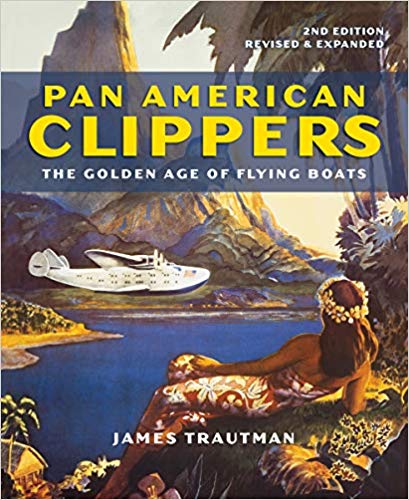
The photographs and artwork will enable readers to grasp the magnificence of the transoceanic flying boats…The accurate, authoritative text will provide information that is new to all but the exceptionally well-informed aviation buff and nonspecialist historian.”
–Choice
For a world recovering from the Great Depression, the Pan American Airways Clipper symbolized luxury, adventure and a brighter future. Illustrated with rare period photographs, vintage travel posters, magazine ads and colorful company brochures, Pan American Clippers covers all aspects of the Golden Age of Pan American’s graceful “flying boats.”
This edition has an additional 16 pages to add more historical and current information and provide additional detail and context to the historical importance of the flying boats, including:
- Pan Am’s Art Deco terminals
- the fate of the last Pan Am Clippers and where to see the survivors
- the Foynes Flying Boat Terminal, Ireland
- Trippe and Lindbergh’s groundbreaking flight to Asia by way of the Great Circle Route (Canada-Alaska-Siberia-Japan-China)
- Shediac, New Brunswick, landing site of 24 Savoia Manchetti S-55 flying boats from Rome en route to Chicago’s Century of Progress International Exposition
- Pan Am enters politics when Frank Roosevelt uses it in Latin America to sidestep the World War II Neutrality Act
- Trippe’s long-held dream of flying mail and passengers across the Atlantic Ocean to Europe, and the opening of LaGuardia Airport.
Visionary Pan Am founder Juan Trippe knew the importance of international travel to the 20th century, and his pioneering airline played a central role in the advancement of transoceanic flight, setting overseas time and distance records, providing airmail delivery and eventually as troop and cargo transports for the Allies during World War II. By dramatically reducing travel time and opening up international air travel to the general public, Pan Am Clippers forever changed the world.
This captivating, informative and richly illustrated book takes readers back to a time of glamor, romance and progress, when dreams once thought impossible were suddenly a reality.
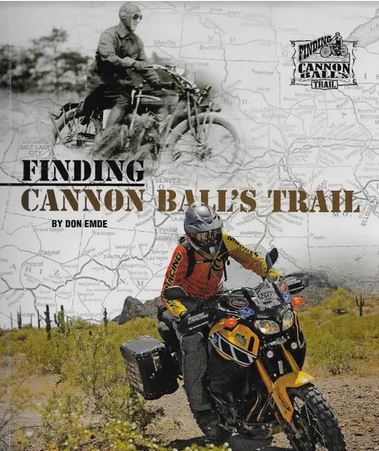
Just before midnight on May 14, 1914, a ferryboat departed from Weehawken, New Jersey and chugged along in the darkness across the Hudson River to Manhattan. On board was a tired-looking rider with an equally tired-looking motorcycle. The boat landed at ten minutes after midnight and there to greet him were representatives from the Federation of American Motorcyclists, the nation’s major motorcycle sanctioning organization. What they knew was that this rider, Erwin G. Baker, had just completed the fastest transcontinental trip in American history.
Baker’s journey of 3,497 miles had taken him 11 ½ days. And, oh, what an incredible 11 ½ days it was! After leaving San Diego on May 3rd he rode coast to coast, averaging only four hours sleep each night. Danger seemed to await him at every turn. In the Arizona desert he ran out of gas and had to push his motorcycle five miles in the sand in 119-degree heat. When he got to New Mexico he hit some rainy weather, which turned the historic Santa Fe Trail into a deep mud bog. He suffered six flat tires once on the same day, which he had to repair with the tools he carried with him, and in Pennsylvania he rode 232 miles of mud in a steady downpour. Despite all this, Baker continued east as fast as he could legally go. When he landed on Manhattan, he had smashed the current record holder’s long-standing record by more than nine days. His amazing journey concluded at the Hotel Astor in New York City where he was met by journalists wanting to get the story. One shouted out that he had “shot across the country like a cannon ball.” He was forever more Cannon Ball Baker!
In 2011, Don Emde, a former winner of the prestigious Daytona 200 motorcycle race and 1999 Inductee to the Motorcycle Hall of Fame, embarked on a multi-year project to understand the riding conditions and retrace the route that Cannon Ball Baker had taken in 1914. Using modern day computer search tools, GPS, and current adventure-style motorcycles, he and an assistant, Joe Colombero, logged numerous miles in the California and Arizona desert to work out what remains of the dirt roads that Baker had ridden. Their research ultimately took them on a ride all the way to New York City on the same route that Baker had taken. Their discoveries and difficulties is a great story in itself. Finally, in 2014, Emde led a group of 30 motorcyclists on a celebration ride from San Diego to New York City, just as Baker had done a century before. The group departed on May 3rd—100 years to the minute from when Cannon Ball had left San Diego—and arrived in New York just as he had on May 14th.
This is the story of three epic motorcycle rides across America.
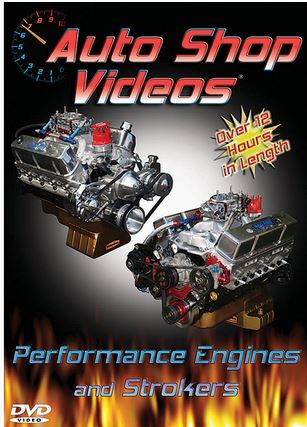
The ultimate video on how to build any kind of performance engine, including numerous types of big cubic inch strokers! Almost 13 HOURS of IMMENSE, HIGHLY DETAILED information! You’ll see exactly what to do, and how to do it, for building your own high performance street or strip engine in your own garage, including how to clearance it for building a monster stroker! It is absolutely packed with information, techniques, tips and tricks that you can’t just learn anywhere! You are taken through the entire build of a monster 600 HP 408 cubic inch small block Ford stroker, PLUS a 383 small block Chevy to show you all of the differences (and similarities) of building pretty much any kind of stroker or performance engine.

Ah, Washington: evergreens, coffee, rock, and rain. That’s pretty much it, right? Well, no. There is a whole lot of weird going on in our state. Washington is home to some of the weirdest travel destinations, scariest legends, and most colorful folks in the United States.Because there are so many odd and unusual tales, cemeteries, beasts, and people here, it took two authors to traverse the state to document it all. With cameras and notepads, and apples (of course) in hand, Jefferson Davis and Al Eufrasio boldly ventured the highways and byways, back roads and forests, shorelines and mountaintops to investigate all the state has to offer. For starters, there are lots of unexplained events here–in fact, we’re ranked number two in the whole country for mysterious phenomena: America’s only unsolved hijacking happened here; look up, but watch out for raining rocks, mysterious flying men, and UFOs; look down, and you might uncover a body turned to soap in Crescent Lake or deadly monsters in Lake Washington.Where else can you find a tribute to a giant squirting razor clam? Discover Ozette, our own Pompeii of the Pacific Northwest, cruise by Gospodor’s monumental controversy on your way to Gravity Hill, but if that’s Bigfoot you see, no worries because here in Washington, Bigfoot saves lives! Investigate the elusive Northwest tree octopus, feed a hungry ghost at Starvation Heights, and see what’s not going on in Aberdeen. Yes, Washington is a whole lot weirder than you ever imagined, and “Weird Washington” is here to show and tell you all about it.

When you open Strange 66, take a look beyond the all-American sheen to the seedy, creepy, and just plain weird stories behind America’s Mother Road.
Route 66 conjures images of an innocent golden age of car travel: shiny V8s powering down hot, two-lane blacktop, sucking 20-cent-a-gallon gasoline, and periodically depositing their occupants at mom-n-pop greasy spoons, neon-lit motels, and tourist traps. But America’s Mother Road wasn’t all about ruddy-cheeked, summer vacationers. Route 66 and the regions it traverses have a side more seldom seen, rich with weird tales (mimetic architecture, paranormal phenomena, and even cryptozoology) to the downright sordid and seedy (murder, mistreatment, and other assorted mayhem).
In Strange 66, bestselling Route 66 authority Michael Witzel explores the flip side of Route 66 to offer details on infamous Route 66 locations that once served as hideouts for the James Gang (Meramec Caverns), Bonnie and Clyde (Baxter Springs, Kansas), and Al Capone (Cicero, Illinois).
There are the stories of unspeakable crimes committed along 66, such as the Stafflebeck “murder bordello” in Galena, Kansas, and Ariziona’s “Orphan Maker of Route 66.” Witzel also explores the people that passed through the region, including the Dust Bowl exodus and the Trail of Tears tribute in Jerome, Missouri.
Then there are the lighter, though still strange stories, such as the Route 66 Great Transcontinental Footrace and the origins of various roadside colossi, like the Blue Whale of Catoosa and Giganticus Headicus in Walapai, Arizona. And speaking of heads, what about steak? Eat one as big as your head at the Big Texan in Amarillo—and it’s free!
All of these stories culminate in a look at Route 66 unlike any other, completely illustrated with modern and archival photography and written by an acknowledged authority on the Mother Road.

Discover the world of TIG Welding.
This book is aimed at people new to TIG welding mostly learning for their own uses and those who have been away from it for quite some time and are looking to get back into it. Learning TIG may seem quite intimidating or if your not getting the results your looking for in your welds this book can help you get into this Fabrication method & guide you in the direction of Mastery. The book is setup in a need to know format and a first pass read takes about an hour or two in total. While you can hunt down and gather this info for free from other sources across the vast ocean known as the Internet as I did in the Beginning your looking at a 10 – 100X investment of your time with a good amount of confusion and potential to head down the wrong path. So in the end what’s your time worth? Success leaves clues, this book can be your map along the Journey.
If your going to Tech school / college to become a professional Welder this book may be of some assistance as an extra boost however most of this material will be covered in your course & lab work, just strung out over months.
If your an existing professional TIG welder already with Lincoln Electric or Miller tattoos on you biceps, flaming skull Welding helmet to match & a “TIG Life” bumper sticker on your Hot Rod I admire your skills and dedication but this book would be to elementary for someone of your skill level. .
Their are many kinds of Structures where TIG Welding is the most ideal Fabrication method, these include:
Custom Car Frames
Airplane Fuselages
Engine Mounts
Exhaust Systems
Motorcycle Frames
Bicycle Frame
Off Road Buggy Frames
Metal Part Repair
Metal Sculpture Art
Tooling & Shop Equipment
In this book you will learn about:
Shop Safety
The different types of TIG welder machine technology
Equipment Selection
Where to Spend & Where to Save
Material Prep
Setups
Detailed TIG welding methods
and much much more.
Order this Book Today & Get Started on your Journey






















